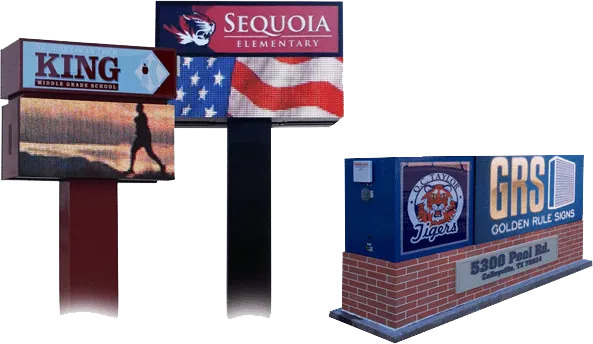Indoor LED signs have become an essential tool for businesses, offering vibrant and dynamic displays to attract customers, convey information, and enhance the overall brand experience. Whether you run a retail store, restaurant, corporate office, or any other business, indoor LED signs can elevate your interior aesthetics and improve communication with your target audience. However, with sao many options on the market, selecting the best indoor LED sign that suits your needs can be overwhelming. This blog post will guide you through the essential features to consider when choosing indoor LED signs, helping you make an informed decision for your business.
Why Indoor LED Signs Are Important for Your Business
In today’s competitive market, businesses need to stand out, and one of the most effective ways to do this is through eye-catching visual displays. Indoor LED signs provide a versatile platform to showcase your brand, promote products or services, and keep customers informed with dynamic content.
Unlike traditional signage, LED signs are customizable, energy-efficient, and long-lasting. They can be used for various purposes, from showcasing daily specials in a restaurant to displaying announcements in a corporate lobby. By choosing the right indoor LED sign, you can transform your business space into a visually engaging environment that draws attention and encourages interaction.
Key Features to Consider When Choosing Indoor LED Signs
Selecting the best indoor LED signs for your business involves evaluating several key features. Each feature contributes to the overall performance, functionality, and aesthetic appeal of your signage.
1. Display Resolution and Pixel Pitch
One of the most important factors when choosing an indoor LED sign is the display resolution. The resolution determines how clear and detailed the images, text, and graphics will appear on the screen. High resolution is especially crucial for signs that will be viewed up close or in environments where clarity is paramount, such as retail stores or corporate offices.
What Is Pixel Pitch?
Pixel pitch refers to the distance between the center of one LED cluster (or pixel) and the center of the next. The smaller the pixel pitch, the higher the resolution of the display. For indoor settings where viewers are close to the sign, a smaller pixel pitch is recommended to ensure crisp visuals.
For example, a pixel pitch of 2mm to 4mm is ideal for most indoor LED signs used in corporate lobbies or retail environments. The smaller the pixel pitch, the better the image quality, though signs with smaller pixel pitch are generally more expensive.
2. Brightness and Viewing Angle
Indoor environments vary greatly in terms of lighting conditions. Some spaces, like retail stores or malls, are brightly lit, while others, such as restaurants or hotel lobbies, have more ambient lighting. Your indoor LED sign should have adjustable brightness levels to ensure that it remains visible regardless of the surrounding light.
How Bright Should Your Indoor LED Sign Be?
For indoor applications, LED displays typically have a brightness range of 600 to 1,200 nits. While higher brightness levels are important for outdoor signs, indoor signs do not require as much intensity. However, it’s essential to choose a sign with adjustable brightness settings to avoid glare in low-light environments and ensure visibility in brighter spaces.
In addition to brightness, the viewing angle is another critical consideration. The viewing angle refers to the maximum angle at which the sign can be viewed without the image or text becoming distorted. A wider viewing angle ensures that people can clearly see your message from different parts of the room. Look for signs with a viewing angle of at least 120 degrees horizontally to guarantee good visibility.
3. Content Management System (CMS) Compatibility
The content displayed on your indoor LED sign will likely need frequent updates. Whether you’re promoting new products, running special offers, or displaying corporate messages, having an efficient content management system (CMS) makes a big difference in managing your signage.
Why CMS Matters
A good CMS allows you to schedule, update, and manage content remotely. Many best indoor LED signs come with integrated CMS platforms that are easy to use, letting you control multiple screens from one central location. Look for systems that offer cloud-based management so you can update content from any device, anywhere.
Additionally, check whether the CMS supports different types of media such as images, videos, text, and animations. A flexible CMS will allow you to create dynamic, engaging content that keeps your audience interested.
4. Size and Installation Options
The size of your indoor LED sign will depend on the space where it will be installed and its intended purpose. Larger signs are ideal for open areas such as shopping malls or conference halls, where the sign needs to be visible from a distance. Smaller signs work well for more confined spaces such as retail counters, waiting rooms, or reception areas.
Choosing the Right Size
Before making a decision, measure the available wall or ceiling space where the sign will be mounted. Keep in mind that the sign should be proportionate to the room size; a sign that’s too large may overwhelm the space, while a sign that’s too small may not be noticed.
In addition to size, consider the installation options. Wall-mounted signs are common, but you can also opt for hanging or ceiling-mounted signs depending on your space and desired aesthetic. Some LED signs are designed for freestanding use, which can be a great option for exhibition spaces or pop-up displays.
5. Durability and Lifespan
While indoor environments are generally less harsh than outdoor ones, durability is still an important factor to consider. The best indoor LED signs are designed to be robust, with a lifespan of over 100,000 hours. Look for signs made from high-quality materials that can withstand the wear and tear of daily operation, especially in high-traffic areas like retail stores or hotels.
LED Lifespan and Warranty
Most indoor LED signs are rated for tens of thousands of hours of operation before needing replacement. However, not all LED signs are created equal in terms of build quality. To ensure your sign lasts as long as possible, choose a product from a reputable manufacturer that offers a comprehensive warranty, typically ranging from three to five years.
6. Energy Efficiency
Energy efficiency is another important consideration, particularly for businesses that plan to use their LED signs around the clock. LEDs are generally more energy-efficient than other types of lighting, but there are still variations in power consumption among different models.
Why Energy Efficiency Matters
Choosing an energy-efficient indoor LED sign not only helps reduce your electricity bills but also contributes to your company’s sustainability efforts. Look for LED signs with energy-saving features like automatic brightness adjustment and power-saving modes.
Common Uses of Indoor LED Signs
Now that we’ve covered the key features to look for, let’s explore some of the most common applications of indoor LED signs and how they can enhance your business.
Retail Stores
Retailers often use LED signs to showcase promotions, sales, or new arrivals. These signs can be strategically placed near entrances or inside the store to grab the attention of shoppers and encourage purchases.
Restaurants and Cafés
In restaurants, LED signs can be used to display daily specials, menus, or promotional offers. The bright, dynamic display attracts customers and provides clear, easy-to-read information, even in low-light settings.
Corporate Offices
For corporate settings, indoor LED signs serve as an effective communication tool. They can display important announcements, meeting schedules, or branding messages, adding a modern touch to lobbies and conference rooms.
Event Spaces and Theaters
Indoor LED signs are ideal for guiding attendees at large events, displaying schedules, or showcasing sponsors. They can also be used to provide real-time updates or engage attendees with live social media feeds.
Conclusion
Choosing the right indoor LED signs for your business is an investment that can enhance customer engagement, improve communication, and elevate your brand’s visual presence. By considering factors such as display resolution, brightness, content management capabilities, size, and energy efficiency, you can find the best indoor LED signs that meet your specific needs.
Whether you’re outfitting a retail space, restaurant, corporate office, or event venue, high-quality indoor LED signs can make a lasting impression and deliver value for years to come. With the right features and strategic placement, these signs will help you communicate more effectively with your audience and keep your business at the forefront of visual innovation.




